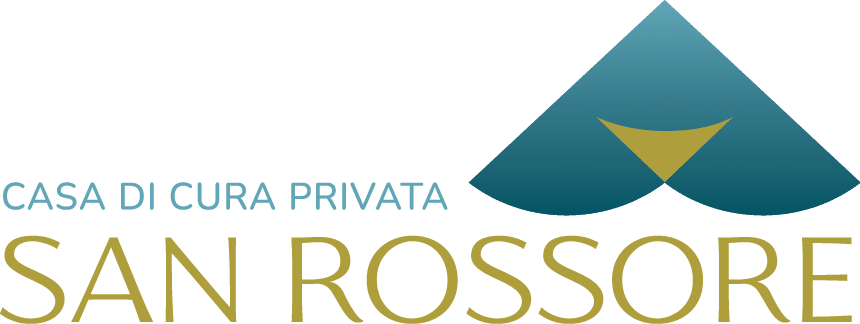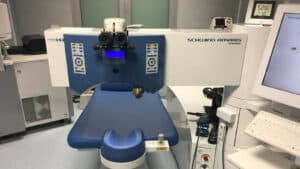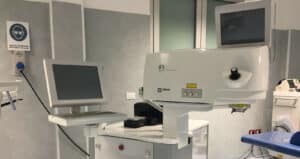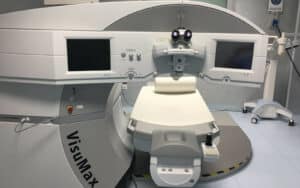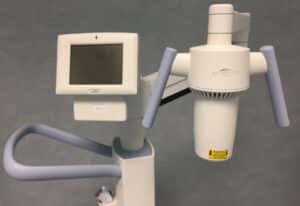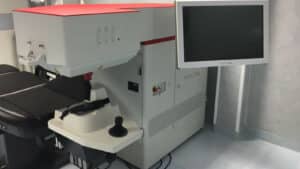Eye surgery
Eye Surgery
At Casa di Cura San Rossore you can find the following services:
- Ophthalmology outpatient clinic with
– OCT (retinal tomograph) for the diagnosis of macular diseases
– Angiograph for diagnosis of retinal pathologies
– Visual field to study glaucoma damage and neurological problems
– Corneal map for corneal topography - YAG and Argon laser for retinal pathologies and secondary capsule opacities after cataract surgery
- State-of-the-art laser center for correction of refractive flaws, corneal pathologies and keratoconus
- Pediatric ophthalmology
The operating room among the Ophthalmology equipment has a high-speed Vitrectome for minimally invasive retinal surgery and a state-of-the-art Phacoemulsifier for cataract removal, using ultrasound or vibration. Prof. Stanislao Rizzo’s team also performs Retinal Prosthesis surgeries on patients with retinitis pigmentosa.
Eye Center for Laser Surgery
A center entirely dedicated to the care of your eyes
The Eye Center for Laser Surgery is the first in Italy to have all the most advanced technologies currently on the market.
In fact, it is equipped with state-of-the-art instrumentation to treat all possible visual defects.
For info write to chirurgiarefrattiva@sanrossorecura.it or call the secretary’s office at 050 586424
Performance and therapy
- Next-generation ECCIMER LASER for the treatment of refractive situations. This innovative laser represents the highest level of technology on the market today. Thanks to the truncated hypermetrophic profile, developed by Prof. Paolo Vinciguerra, the Excimer Laser is able to create maximal optical zones that avoid nighttime halos, a typical and annoying complication of previous refractive treatments.
- FEMTOSECONDI LASER (click on the name to view the introductory video), for creating super-thin 90-micron flaps, allows Femto Lasik to be performed with maximum corneal tissue sparing. Si tratta della tecnica ad oggi più avanzata per la correzione di ogni tipo di difetto visivo ed è la metodica scelta dalla NASA e dai corpi militari US, per la sicurezza ed i risultati che garantisce. The treatment involves the creation, by femto laser, of a very thin corneal lamella (flap), which is raised to perform excimer laser treatment of the visual defect in the deeper layers of the cornea itself. When the treatment is finished, the flap is repositioned in its initial location, where it naturally adheres in a few seconds by capillarity, as if it were a natural contact lens. The use of this machine also enables the performance of other types of corneal surgeries, such as Corneal Transplantation, the implantation of Intracorneal Rings, and the creation of Intracorneal Pockets for the implantation of Presbyopia corrective micro-lenses.
- FEMTO LASIK ZEISS VISUMAX click on the name to view the introductory video), for performing the innovative procedure Smile, or the treatment of the vices of Myopia and Astigmatism, through micro-cutting and extraction of a corneal lenticule. This type of surgery, which allows us to correct the defect without weakening the cornea and without having to cut its nerves, is reserved for sportsmen, high myopes and those who suffer from dry eye.
- CROSSLINKING ACCELERATED allows the treatment of keratoconus and strengthening of the cornea during a Femto Lasik treatment, where it is deemed necessary (ex. thin corneas).
- FEMTO CATARACT (click on the name to view the introductory video in English), for the treatment of cataracts, performed in the operating room. The Femto Cataract allows the lens to be shattered with the eye closed, ensuring maximum precision and safety for the patient, and spares the cornea from ultra-sonic suffering in the most absolute way, which happens in traditional cataract surgery. Following this treatment, multifocal lens implantation can thus be carried out at a later date for the correction of refractive defects, both near and far, in complete safety.
Benefits available for pediatric ophthalmology:
- Examination of the orbital region
- Examination of dioptric media
- Examination of reflexes
- Assessment of visual function and possible measurement of acuity
- Assessment of visual axis alignment and examination of extrinsic ocular motility
- Evaluation of refractive defects
- Ocular fundus examination
- Ocular ultrasound
- Ultrasound of the lacrimal tract
- Autorefractometry
- Transpalpebral tonometry ( congenital/infantile glaucoma screening)
The Child’s Visit
From a practical point of view, it will be useful to make an initial examination in the very first months of life, to exclude the presence of defects that hinder normal development, always taking into account, in analyzing the child’s responses, physiological immaturities due to age.
In the event that this checkup shows no signs of pathology, a second checkup can be done around the 3rd year and then around the 5th, this is to prevent possible amblyopia due to factors that in the neonatal examination may not yet have presented themselves.
Examining the child requires a proper strategy in scheduling the various stages of the examination, postponing those diagnostic tests that strain the relationship with the young patient (since they require, for example, the application of eye drops)and those that are only secondary or incidental to the diagnosis.
It is perhaps superfluous to emphasize, therefore, that the order of investigations we suggest will then be usefully adapted by the specialist to individual cases.
The Phases of the Visit
- Family, maternal and personal history
- Inspection of the face and orbital region
- Examination of dioptric media
- Examination of reflexes
- Assessment of visual function and possible measurement of acuity
- Assessment of visual axis alignment and examination of extrinsic ocular motility
- Evaluation of refractive defects
- Ocular fundus examination
- Ocular ultrasound
- Ultrasound of the lacrimal tract
- Autorefractometry
- Transpalpebral tonometry ( congenital/infantile glaucoma screening)
Referring specialists
Nothing found.
Orbito-palpebral surgery
WORK IN PROGRESS
Page under construction
For information contact +39 050 586217 or send e-mail to info@sanrossorecura.it
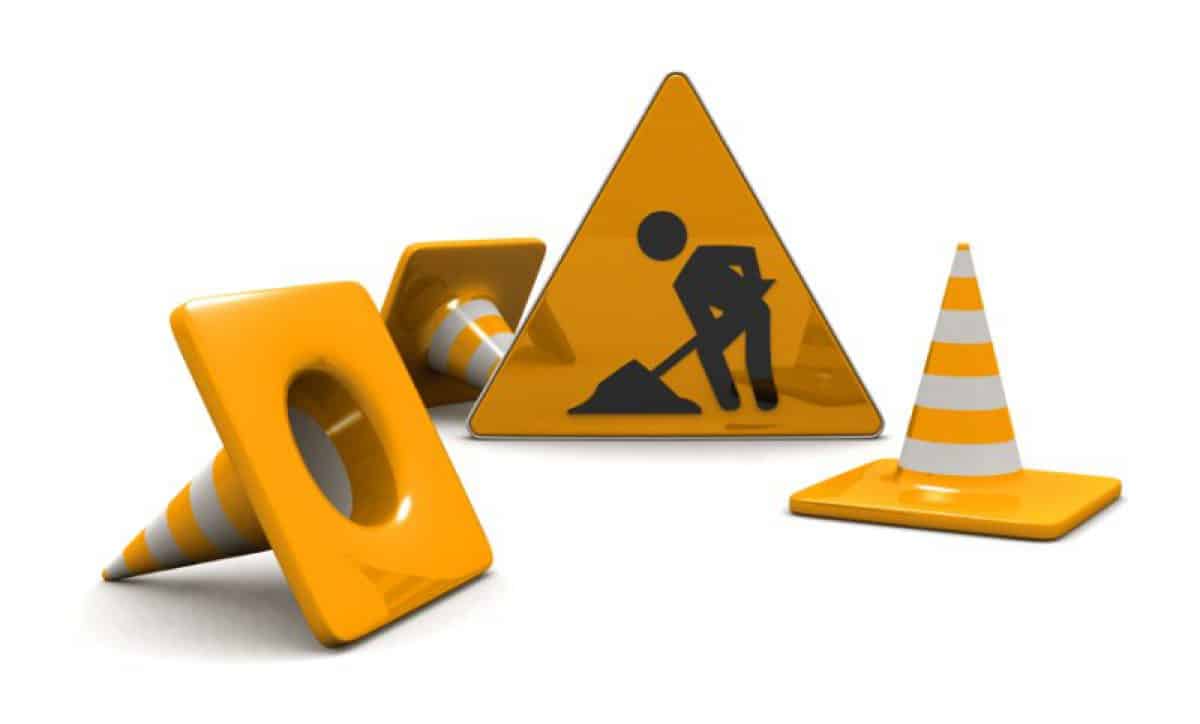
Reconstructive and aesthetic plastic surgery
Reconstructive and aesthetic plastic surgery
Reconstructive and Aesthetic Plastic Surgery repairs defects of the skin and soft parts, as well as the musculoskeletal system, cranial and peripheral nerves. It is not organ surgery, but ranges over all apparatus, covering and supporting and intervenes where morpho-functional reconstruction is needed. It acts where and when age modifies features, corrects where Mother Nature has not given her best.
All interventions are executable by our specialists.
RECONSTRUCTIVE PLASTIC SURGERY
The Reconstructive Surgery repairs all losses of substance, of skin, muscles and covers noble tissues such as bones and joints. In particular, it reconstitutes the continuity of the protective covering of the body, which is essentially the skin. In addition, this particular branch of Plastic Surgery repairs malformations, whether congenital or acquired, e.g., cheilopalatoschisis, craniofacial malformations, facial paralysis, many syndromes with multiple malformations, angiomas and vascular malformations, and the outcomes of removal of soft part tumors.
Executable treatments:
- Removal of benign skin formations (nevi, cysts, angiomas, lipomas, other)
- Removal of malignant skin formations (epithelioma, melanoma, other)
- Correction of scars.
- Decompression of peripheral nerves (carpal and tarsal tunnel syndrome, ulnar nerve and superficial peroneal nerve compression), including for diabetic neuropathy.
- Nerve repairs with sutures and grafts
- Dupuytren’s disease
(Aponeurotomy for Dupuytren’s Disease and lipofilling: minimally invasive treatment of Dupuytren’s Disease or retraction of the palmar aponeurosis: new surgery that avoids long incisions and allows faster healing - Correction of sidactyly of hands and feet
- Repair of tendon injuries
- Finger snap
- Onychocryptosis
- Mucosal cysts
- Skin grafts for loss of substance of the trunk and limbs.
- Proximal, axial and perforating flaps for substance loss reconstructions.
- Microvascular flaps.
- Treatment of ray dermatitis with flaps and fat grafts
- Excisions of vascular malformations and angiomas
- Gynecomastia
- Breast reconstruction with implants, flaps and fat grafts
- Correction of breast asymmetry with fat grafts or implants
- Introflected nipples
- Plastic for phimosis
- Rhinophyma
- Gill cysts and fistulas
- Dermoid cysts
- Thyroglossal duct cyst
- Parotid gland surgery
- Facial paralysis surgery
- Removal of xanthelasmas
- Correction of eyelid ptosis
- Entropion and ectropion
AESTHETIC PLASTIC SURGERY
The Aesthetic Surgery corrects cosmetic flaws and improves an individual’s appearance e.g. corrects the shape of the nose, fan ears, receding or prominent chin, breasts that are too small or too large, sagging abdomen, wrinkles in the face and neck, and “tired” eyelids.
Executable treatments:
- Blepharoplasty
- Correction of fan ears
- Forehead, face and neck lifting
- Rhinoplasty
- Mastopexy
- Breast augmentation with implants or with fat grafts
- Reduction mammaplasty
- Correction of cleft earlobes
- Abdominoplasty
- Arm and thigh lifts
- Liposculpture
- Lipofilling
- Dermabrasion
- Cosmetic surgery of female genitalia
Referring specialists
Nothing found.
Anesthesia and resuscitation
Anesthesia and resuscitation
Main anesthesia and sedation techniques:
- General anesthesia
- Regional loco anesthesia: central and peripheral blocks
- Partoanalgesia
- Postoperative pain therapy
- Deep sedation activities for invasive diagnostic gastroenterology and medically assisted procreation techniques.
Useful numbers
Head nurse
Saida Kraich
Tel. +39 050 586404
Performance and therapy
- General anesthesia. It is induced through the use of hypnotic and analgesic drugs administered intravenously, followed by maintenance by inhaled or intravenous drugs. Often patients under general anesthesia are immobilized with muscle relaxant drugs and thus require full respiratory function support via artificial ventilators. At the end of surgery, the action of these drugs is antagonized and anesthesia relieved until the patient fully recovers his or her ventilatory autonomy. Patients are then transferred to an awakening area, from where they are discharged to return to the ward at the time of complete recovery of consciousness and cardiorespiratory homeostasis.
- Loco-regional anesthesia. There are many techniques of loco-regional anesthesia. The most commonly used are spinal anesthesia and epidural anesthesia. These techniques involve injection of local anesthetics within the dural sac or into the epidural space with blockage of nerve fibers carrying painful information from the periphery to the central nervous system. Spinal and epidural anesthesia are performed individually for limb or lower abdominal surgeries, while for upper abdominal surgeries they are routinely combined with sedation for patient comfort. Generally, epidural anesthesia involves the placement of a catheter that allows local anesthetics and analgesics to be infused for the first few days after surgery, optimizing pain control and thus the patient’s functional recovery after surgery.
- Peripheral blocks. It is a technique used for orthopedic procedures involving the extremities.
- Local anesthesia. Instead, many surgical procedures, such as eye surgeries or outpatient surgeries, are performed with local anesthesia by direct infiltration of anesthetic mixtures at the site of injury. Usually more or less deep sedation is combined to give better results.
Surgery is always accompanied by pain both at the wound site and in areas distant from the wound.
Treating acute postoperative pain, in addition to ethical reasons, stems from the observation that it is accompanied by pathophysiological changes in organs and systems, which can expose the patient to various complications.
Such a service is therefore of paramount importance because reduces postoperative issues and accelerates the patient’s recovery, decreasing the days of hospitalization.
Adequate pain treatment cannot be achieved without the continuous patient monitoring and the close cooperation between medical and nursing staff.
The organizational model adopted by the Casa di Cura San Rossore involves cooperation between the following professional figures:
- The anesthesiologist applies protocols, performs quality control, evaluates benefits and side effects, and assesses the patient’s pain.
- Inpatient nurse: monitors vital parameters, administers therapy and detects the extent of pain.
Childbirth pain is very intense: treating the pain of labor can help not only to improve the quality of life of the mother-to-be, but also to reduce the effects that the pain itself causes on the maternal-fetal unit.
Birth is divided into three moments, referred to as the dilatative phase, expulsive phase, and secondment phase. The accompanying pain can be described as biphasic. The dilatational phase is characterized by intermittent, poorly localized pain that is synchronous with uterine contractions and increases as the cervix dilates.
As labor progresses, the expulsive phase approaches, and the presented part descends, the pain becomes more localized and more intense: the patient feels it in the pelvic, vaginal, and perineal sites.
The purpose of epidural analgesia is to take away the painful sensation;
Epidural puncture, performed at the lumbar intervertebral level, can be performed in any consenting patient in whom there are no clinical contraindications.
The anesthesiologist positions the epidural catheter and begins administration of medication: contractions will gradually appear less painful until they are felt as a sense of pressure.
Pain reduction does not imply muscle paralysis, so the woman can move and walk.
The epidural catheter can be leveraged to give epidural anesthesia for an eventual cesarean section, administering a more concentrated dose of anesthetic drug.
It has 3 operating room and a delivery room dotted of anesthesia equipment with automatic ventilation system and continuous cardiovascular and respiratory monitoring, anarea for awakening and preparing the patient.
MAIN TREATMENTS
- Intensive treatment of critical patients, in particular:
- Treatment of respiratory failure;
- Treatment of cardiovascular failure (septic, hypovolemic and cardiogenic shock);
- Pharmacological/dialytic treatment of acute renal failure associated with cardiovascular, respiratory, or septic conditions;
- Intensive vital function monitoring of surgical and post-surgical patients
- Assisting/sitting at the Conventional Radiology Service (assisting during the introduction of contrast medium in allergic patients)
- Care/seating at the Endoscopy Service
The Anesthesia Service uses treatment protocols based on major national and international guidelines.
Features:
4 inpatient beds equipped for complete hemodynamic monitoring, with mechanical respiratory assistance system capable of providing various forms of ventilation and infusion pump systems to precisely administer drugs and nutrients.
Referring specialists
Nothing found.
Thoracic surgery
Thoracic surgery
Thoracic surgery deals with diseases inherent to the organs in the chest particularly the chest wall, lungs, pleurae of the esophagus and mediastinum.
Benefits offered
- Diagnosis staging and treatment (surgical, radiotherapy and chemotherapy) of lung cancer;
- Diagnosis staging and treatment (surgical, radiotherapy and chemotherapy) of pleural tumors;
- Diagnosis and treatment of pleural effusions (either by thoracentesis or drain placement; transthoracic);
- Needle biopsies and needle aspiration of chest wall lesions and lung lesions reaching the wall.
Referring specialists
Nothing found.
Bariatric surgery
Bariatric surgery
The Bariatric Surgery is performed almost exclusively through minimally invasive surgical access such as laparoscopy or highly minimally invasive and reversible procedures such as gastric banding and gastric bypass. But there are also irreversible surgeries such as vertical gastrectomy (sleeve gastrectomy) and bilio-pancreatic diversion with/without duodenal switch.
Each of these interventions affects weight loss and therefore also the resolution of co-morbidities with different effectiveness.
The decision to perform one rather than another is derived from the careful assessment of the type of obesity (gynoid/visceral), BMI, the patient’s eating habits, and thus the presence or absence of severe eating disorders, as well as the presence of associated conditions such as Type 2 Diabetes Mellitus.
Related articles
Referring specialists
Nothing found.
Urological surgery
Urological Surgery
Urological Surgery in general deals with traditional surgery, urological endoscopy, and to some extent genital surgery.
In addition to traditional urological surgery and endoscopy, urogenital reconstructive surgery techniques have been perfected at Casa di Cura San Rossore.
In fact, urogenital reconstructive surgery is a superspecialty branch that is gaining an increasingly insistent foothold in the international surgical scene.
The diseases that require the intervention of the urogenital surgeon are varied. Among many:
- Neoplastic pathology of the genitals, in which demolitive surgery was used until now.
- Penile cancer, for which, until recently, amputation of the organ was used, with the obvious functional and psychological consequences, especially in young individuals. Using urogenital reconstructive and plastic surgery techniques, it is now possible to reconstruct the amputated portion with excellent aesthetic and functional results. Then, thanks to erectile dysfunction surgery, hydraulic tricomponent prostheses can be implanted, with resumption of sexual activity.
- La Peyronie’s disease or induratio penis plastica.
- Genital trauma.
- Congenital male genital disorders such as congenital curved penis or hypospadias
- Male incontinence. Some patients undergoing radical prostatectomy for prostate cancer suffer from urinary incontinence: there are currently perineal surgical techniques that allow, with the application of urethral suspension devices, the restoration of continence.
- Female urinary incontinence, for which there are mini-invasive transvaginal techniques that allow restoration of continence.
- Female bladder prolapse, for which there are vaginal surgical techniques that through the application of prolene mesh reconstitute female aesthetic and functional integrity.
- Traumatic pelvic pathology or urethral infections, which can then be responsible for more or less complex stenosis of more or less extensive portions of both the anterior and posterior urethra. With urethral surgery through reconstructive surgery techniques using buccal mucosa or skin grafts, ureral stenoses are reconstructed.
Referring specialists
Nothing found.
Colon-proctological surgery
Colon-proctological surgery
Hemorrhoids or hemorrhoid pathology is the most frequently encountered proctological disease. It is estimated that about 50 percent of the population over the age of 50 in most industrialized countries suffer or have suffered from disorders related to hemorrhoidal disease (hemorrhoids).
The most innovative surgical procedure with regard to the treatment of hemorrhoids is THD (Transanal Hemorrhoidal Arterial Dearterialization), a method that is performed by means of an apparatus to which an anoscope, specially constructed for this use, is connected.
THD is a pioneering method in the treatment of hemorrhoids because it revolutionizes the surgical approach to hemorrhoid disease, ensuring maximum effectiveness of results and minimizing the levels of invasiveness, pain and stress for the patient.
The method that includes dearterization, that is, the selective identification and ligation of the terminal branches of the superior rectal artery, is mucopoxy, that is, the repositioning, thanks to submucosal stitches given from the point of ligation of the artery to the pectine line, of the pads in their natural anatomical location; all under local anesthesia with sedation, so that the patient can restore normal physiology and a rapid post-operative recovery, and without tissue removal. Therefore, in the postoperative period, discomfort for the patient is reduced compared to more invasive methods.
Referring specialists
Nothing found.
